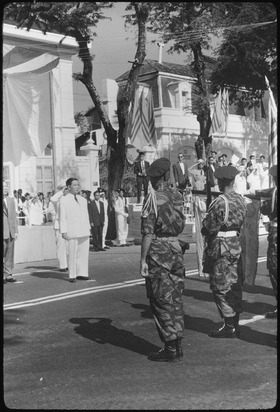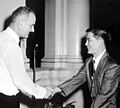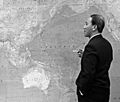1963 South Vietnamese coup d'état facts for kids
Quick facts for kids 1963 South Vietnamese coup d'état |
|||||||
|---|---|---|---|---|---|---|---|
| Part of the Buddhist crisis of the Vietnam War | |||||||
 President Diệm of South Vietnam, deposed in a coup |
|||||||
|
|||||||
| Belligerents | |||||||
|
|||||||
| Commanders and leaders | |||||||
|
|
|||||||
| Strength | |||||||
| Casualties and losses | |||||||
| Civilians: 20 dead, 146 wounded | |||||||
In November 1963, something big happened in South Vietnam. The country's leader, Ngô Đình Diệm, was removed from power by a group of army officers. This event is known as a coup d'état, which is when a group suddenly takes control of a government, usually by force. In South Vietnam, people called it the "1 November 1963 Revolution." This change was a major moment during the Vietnam War.
Contents
Why the Coup Happened
At this time, Ngô Đình Diệm was the president of South Vietnam. He had been in charge since 1955. The United States supported him because they hoped he would help stop the spread of communism from North Vietnam.
However, many people in South Vietnam were not happy with President Diệm. He ruled in a very strict way and often did not listen to the needs of the country's Buddhist majority. This led to many protests and a lot of unrest among the people.
The Coup Begins
On November 1, 1963, a group of South Vietnamese army officers decided to act. They were led by General Dương Văn Minh. These officers believed that Diệm's government was failing and that a change was needed.
The plan for the coup was carefully made. When it started, things went quite smoothly. Many of Diệm's loyal supporters were surprised. The officers quickly took control of important government buildings.
By the next day, President Diệm and his brother, who was also a key advisor, were captured. They both died shortly after their arrest. This event completely changed the political situation in South Vietnam.
How People Reacted
The coup caused different reactions both in Vietnam and around the world. Some people hoped that the new leaders would bring positive changes, especially for the Buddhist community. However, others worried that this sudden change would lead to more problems and fighting.
The United States had been supporting Diệm. They knew about the plans for the coup but chose not to stop it. This decision was very debated and historians still discuss it today.
What This Meant for Vietnam
The 1963 coup in South Vietnam was a very important event in the Vietnam War. It led to many more conflicts and changes in leadership over the years. It showed the deep struggles within the country and how other countries, like the United States, were involved. This event is a key part of history that helps us understand how big political changes can affect a nation and its people for a long time.
Images for kids
-
Diệm's brother Ngô Đình Nhu (right), shaking hands with then US Vice President Lyndon B. Johnson in 1961





